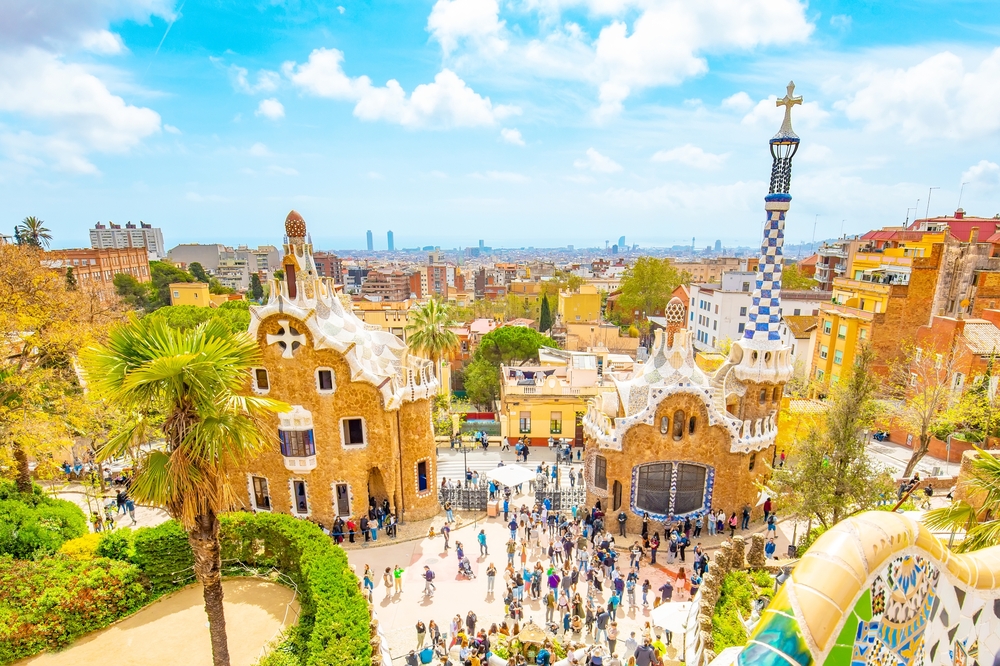
Long-distance markets are emerging as an opportunity to boost high-impact tourist demand to Barcelona, as stated by Mabrian, the global travel intelligence platform. As the forecasts for the next six months indicate, there are three trends among the international source markets that Barcelona must monitor and manage: the recovery of Asian demand, the variability of the North American market, and the growth of demand and connectivity from the Middle East.
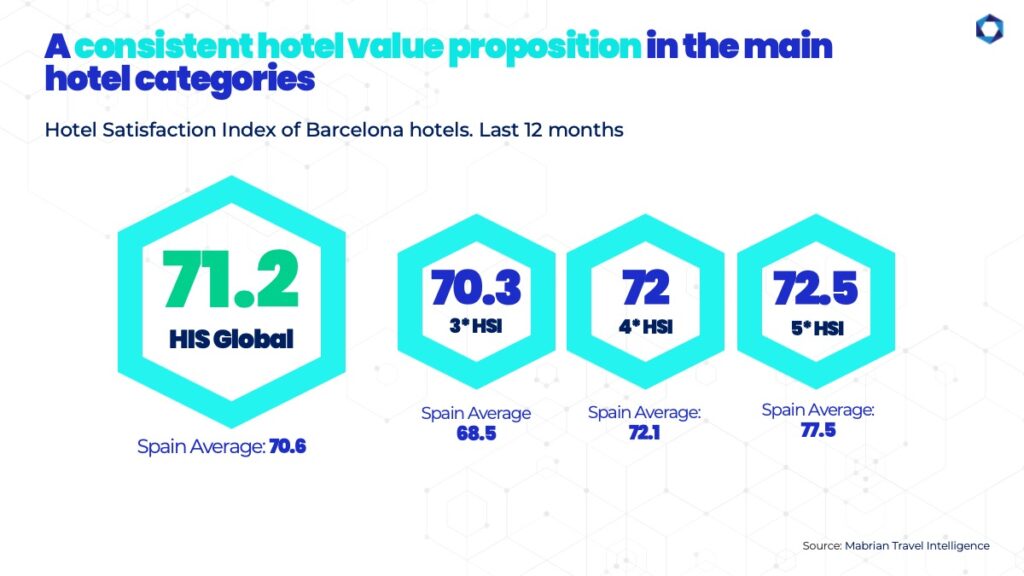
Mabrian shared its conclusions during “Barcelona 2025, the tourism we want”, an event organised by Expedia Group, in a round table that included contributions from Mateu Hernández, general manager of Turisme de Barcelona; Walter Lo Faro, Senior Director – Market Management Southern Europe at Expedia Group, and Sonia Huerta, Director of Mabrian’s Insights & Tourism Advisory area. The debate addressed the three axes of Barcelona’s travel & tourism strategic plan: international positioning, Barcelona’s sustainable development,and the quest for the quality tourism that, beyond its spending profile, establish enhanced interactions and contributions to the economic and social dynamics of the destinations.
Mature destinations have a pending task of great relevance, “changing the mindset to move from destination promotion to focus on demand management and tourists’ flows, a process that many Spanish and European destinations have already embarked on, including Barcelona”. As Huerta states, this requires “more selective approach when prioritising markets and segments,” a task in which tourism intelligence and technology play a crucial role helping to fine-tune the criteria to sort long-distance markets using, for example, studying higher-spending markets in respect to their carbon footprint to reach the destination.
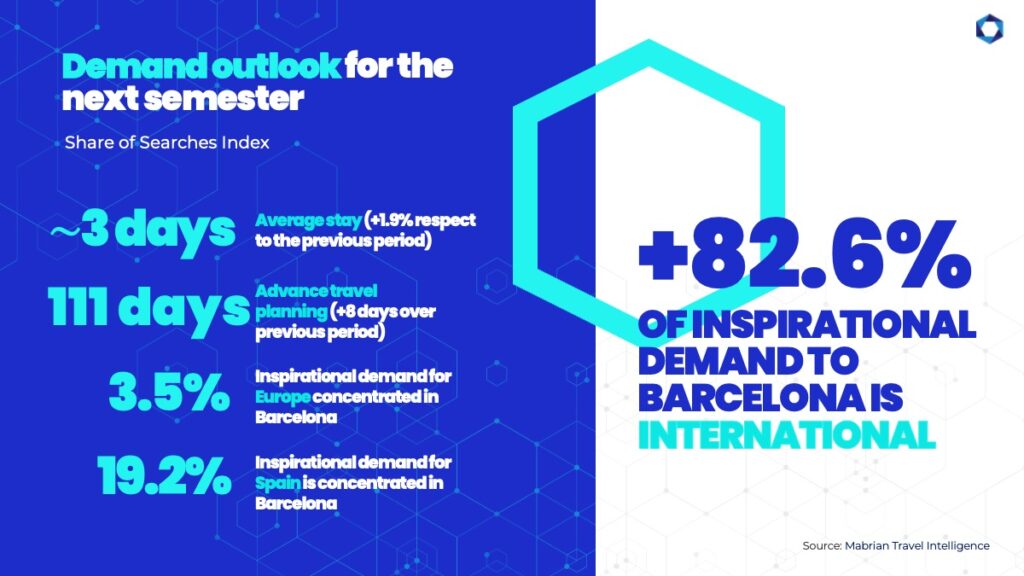
According to Mabrian’s speaker, such effective demand management to appeal high-impact travellers also implies “putting not only the traveller, but also the resident at the centre of the strategy, disseminating and communicating what we do, how we do it and, particularly, how it benefits local communities”.
Air capacity grows in line with the strength of international demand
Mabrian’s forecasts, which reflect Barcelona’s Share of Searches Index* performance for the next six months, show that advance planning increases by up to 111 days (8 more than in the previous period), for stays of approximately 3 days. In addition, this index indicates that, for the period analysed, Barcelona concentrates 3.5% of the inspirational demand to Europe, 19.2% if searches for flights to Spain.
The director of Mabrian’s Insights & Tourism Advisory area points out that, for the next six months, “inspirational demand from international markets remains strong, and represents 82.6% of the total, although it is down 2.4 percentage points compared to the same period last year,” and such travel intention is growing from Canada and the United Arab Emirates, at a slower pace from China, France, Ireland and Italy; and slightly falling from the United States, the United Kingdom, Germany, Portugal, the Netherlands and Switzerland.
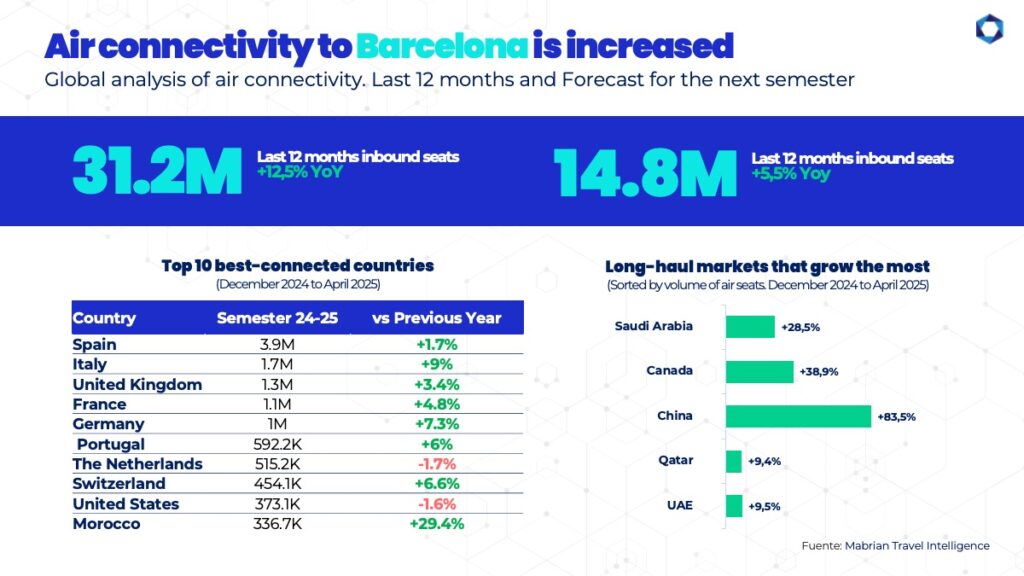
This growing trend in inspirational demand is reflected in the air capacity forecasts to Barcelona. In the last 12 months, more than 31.2 million air seats connected domestic and international airports to Barcelona (+12.5% compared to the same period of the previous year) and, for the coming semester, the Catalan capital will have 14.8 million seats available, +5.5% compared to the same semester of the previous year, thanks to the increase in air seats expected between February and March 2025.
“Air seats to Barcelona will increase from all key and nearby European markets, except the Netherlands, which is slightly decreasing; nevertheless, forecasts from long-distance markets are striking,” explains Huerta. Thus, except for the United States (-1.6%), key long-distance markets are increasing their seats availability to Barcelona,such as the United Arab Emirates (+9.5%), Canada (+39%), Qatar (+9.4%), China (83.5%) and Saudi Arabia (+29%) and, on top of that, Singapore and Hong Kong have new routes scheduled for the analysed period.
A cultural and diverse destination to attract quality tourism
The analysis of demand drivers for the last 12 months prepared by Mabrian for this event shows that culture (38.4%) and gastronomy (12.6%) are the main motivations for visiting Barcelona, and active tourism increases. Placing such experiences “at the core of the tourism product development strategy and the destination’s promotion can help Barcelona to champion the quality tourism value proposition”, suggests the Mabrian consultant. The rest of the demand drivers, which represent the remaining 49%, are distributed in a very balanced way, showing the variety of experiences and the diversity of international demand.
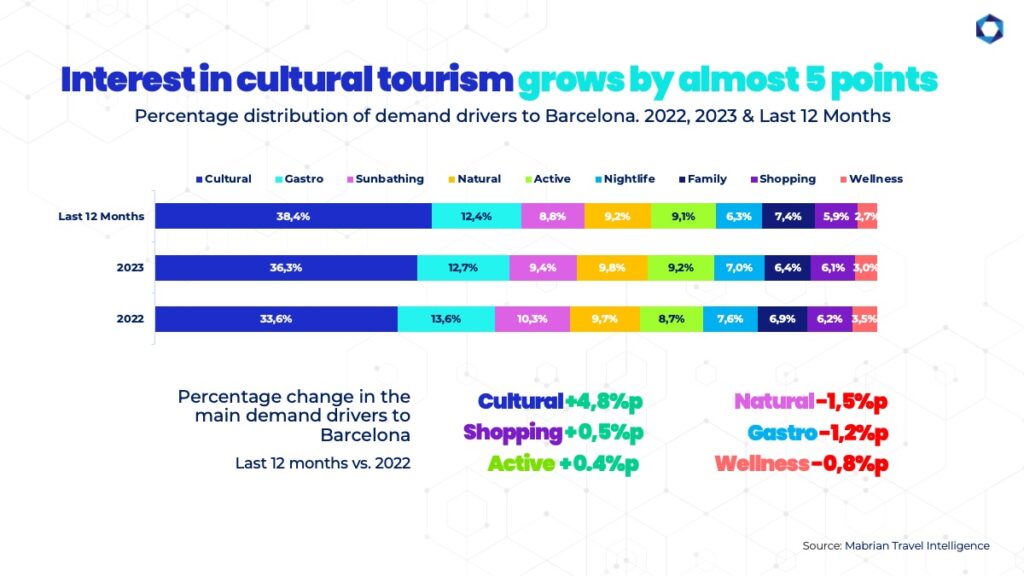
From the destination’s perceptions point of view, an aspect of capital importance to increase the arrival of high-impact travellers, Barcelona must address the effect of the global coverage of the demonstrations against overtourism or the announcement of the ban on tourist rentals, among other relevant news, “The Global Perception (81.6 out of 100 points) and Perception of Security (87.1) indexes are overall high for Barcelona and holding up well, although they are the most impacted ones, showing slight falls,” says Huerta.
The accommodation value proposition is also a very significant factor in attracting this type of traveller, capable of leaving a positive mark on the destination, and it also shows good prospects: in the next six months an average +9% increase in Barcelona’s hotel rates of hotels is expected -3.4 percentage points higher that the Spanish average-, driven mainly by 4-star hotels. In addition, traveller satisfaction with the hotel offer is consistent and fairly uniform between the 3, 4 and 5-star categories.

“The average rates of 5-star hotels remain below those of their competitors in other European destinations, and it is advisable to review pricing strategies to maintain competitiveness by aligning market prices,” suggests Mabrian’s director of the Insights & Tourism Advisory, who also recalled that hotels represent nearly 57% of the demand for tourist accommodation in Barcelona,compared to the remaining 43%, which is divided into hostels and similar categories, and tourist apartments.


Comments are closed.